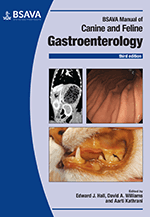
Full text loading...

The cardinal sign of small intestinal disease is diarrhoea, but this can also be caused by disease elsewhere. Conversely, diarrhoea is not always present, and there are many other signs of small intestinal dysfunction, although some are non-specific. This chapter describes the structure and function of the small intestine, and discusses pathophysiology and diagnostic approach.
Small intestine: general, Page 1 of 1
< Previous page | Next page > /docserver/preview/fulltext/10.22233/9781910443361-3e/BSAVA_Manual_Gastroenterology_3_9781910443361-3e.34a.198-203-1.gif

Full text loading...

